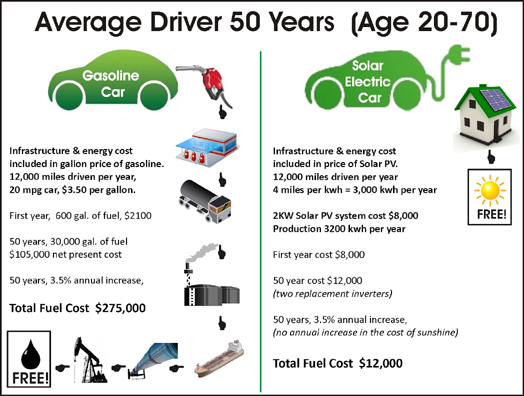
 Putting solar cells onto a car and/or using portable solar units to charge an EV is apparently a flash hot button issue for many electric vehicle advocates, some (many?) of whom patronizingly, in my view, immediately dismiss such efforts as “useless.”
Putting solar cells onto a car and/or using portable solar units to charge an EV is apparently a flash hot button issue for many electric vehicle advocates, some (many?) of whom patronizingly, in my view, immediately dismiss such efforts as “useless.”
My view is different: Why NOT use the surface areas you can to generate electricity, even if it is NOT going to power the EV for all of its miles, maybe only 10%?
My retort to the naysayers, many of whom are allegedly FOR more solar: How is it not MORE “useless” to let EVs sit in the sun, sometimes for very long periods of time — on camping trips, in airport parking lots, etc. — and not tap that sun energy potential?
If you DO tap that limited potential by putting solar cells on an EV and/or using portable fold-up solar cells to charge the car in, especially, long-parked, ideal sun conditions, how does that not add up to MORE THAN “useless,” especially if you are talking about 100s of thousands or even millions of vehicles?
Basically, what is “useless” — and according to whose (patronizing) definition of “useless”?!
In fact, multiple car makers agree with me: Adding solar cells to EV rooftops and frames does make sense.
Some examples (and there are more!) ==>

Aptera Motors
Aptera claims its three-wheeled Aptera vehicle “is the first ‘never charge’ electric vehicle. Its solar system can produce more power per year than most drivers will ever need for the road.” Aptera also claims that the vehicle will be able to travel up to 250 miles without needing a charge.

Fisker Motors
Fisker claims its Ocean SUV with solar cells integrated into its roof will be able to generate up to 1,000 miles of extra driving per year via those solar cells. Fisker boasts as well that the vehicle integrates many different recycled and environmentally friendly(ier) materials into its production.

Humble
Humble claims that solar cells integrated into its forthcoming Humble One will produce enough electricity to produce up to 60 miles of all-electric range per day. According to Slashgear.Com, the Humble One comes standard with over 80 square feet of photovoltaic solar roof panels to capture sunlight and transform it into usable energy.

Lightyear One
Lightyear claims solar on its Lightyear One vehicle will add up to 50–65 km (30–40 miles) of range per day during summer. According to Lightyear, “With its five square meters of solar panels you can drive for months without charging. Comprising solar cells encased in safety glass, the sturdy solar roof and hood live up to rigorous auto industry regulation.”

Sono Motors
Thanks to more than 248 solar cells seamlessly integrated into the body of its solar car, Sono Motors claims that its Sion can add up to 245 km (112 km on average) of driving range per week through solar energy to the car’s battery. The Sion’s liquid cooled battery has a capacity of 35 kWh, which which provides a range of up to 255 km – depending on the weather and driving style.
Various portable solar charging units
Many consumers have built their own portable EV solar charging units with perhaps the most intriguing of these making use of softer material solar cells/units that are much more practical than traditional solar panels because you can easily fold them up and store them.
Doing the TOTAL math: Things DO add up!
Further challenging and problematizing the claim that any attempts to build solar cells into full production sized vehicles are “useless” and the claim that any sorts of smaller portable units used to partially charge an electric car are also allegedly “useless,” let’s do some COLLECTIVE math:
- 1,000 EVs with ZERO integrated solar cells and/or portable solar-charging units = 0 miles worth of driving generated in one hour, 0 in one day, 0 in one week, 0 in one month, 0 in one year.
- 1,000 EVs with limited integrated solar cells and/or portable solar-charging units, say cells that might generate 10 miles worth of driving per day on peak sun days, considerably less than what some of the vehicle makers above claim can be produced, could = 2.5 miles/vehicle/hour, 10 miles/vehicle/day, 70 miles/vehicle/week, 280 miles/vehicle/month, 3,640 miles/vehicle/year, which COULD EQUAL, 3.64 million miles worth of driving each year!
Compare 0 miles generated with 3.64 million — is that “useless” generation of solar electricity?
What do you think: Is adding solar cells to EV surfaces “useless”? Are portable solar charging units also “useless”?
What is your definition of “useless” — and what are your criteria for “useless”?
Finally, why do you get to decide what “useless” is, or is not? 😜


 Few things are as satisfying as knowing that your own, local rooftop solar system is actively, and 100%, filling up the battery of an electric vehicle!
Few things are as satisfying as knowing that your own, local rooftop solar system is actively, and 100%, filling up the battery of an electric vehicle!
 Six months ago, the HOA community that I live in,
Six months ago, the HOA community that I live in, 

 With gas prices rising to an average of nearly $5 per gallon in the United States, a lot of people are complaining.
With gas prices rising to an average of nearly $5 per gallon in the United States, a lot of people are complaining.


 We’ve had a
We’ve had a 
